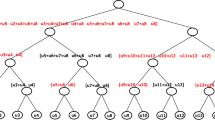Abstract
Recently, the precoded orthogonal frequency division multiplexing (OFDM) was proposed to show robustness to intersymbol interference channels with spectral nulls. However, due to inserting (M-K) zeros between each two sets of K consecutive information symbols, the average transmitting power of the precoded OFDM system reduces by 10 log10 (M/K) dB compared with the conventional OFDM system. Under the same points, inverse fast Fourier transformation (IFFT), the precoded OFDM system has a higher peak-to-average power ratio (PAPR) compared with the conventional OFDM system. This paper proposes a rotated precoder-based OFDM system robust to channel spectral nulls and with reduced PAPR. The rotated precoder makes the N-point IFFT with N/2 zeros padded. Since half of the information symbols for IFFT are zeros, we have the PAPR reduced by 10 log10 2≈3 dB approximately, compared with the conventional precoded OFDM system. We also show that the proposed OFDM system has the same bit error rate (BER) performance as the conventional precoded OFDM system. Both theoretical performance analysis and simulation results are presented to verify the correctness of our theory analysis.







Similar content being viewed by others
References
Feiten A, Mathar R, Reyer M (2008) Rate and power allocation for multiuser OFDM: an effective heuristic verified by branch-and-bound. IEEE Transactions on Wireless Communications 7(1):60–64
Bansal G, Hossain J, Bhargava VK (2008) Optimal and suboptimal power allocation schemes for OFDM-based cognitive radio systems. IEEE Transactions on Wireless Communications 7(11):4710–4718
Zhang H, Xia XG (2006) Iterative decoding and demodulation for single-antenna vector OFDM systems. IEEE Transactions on Vehicular Technology 55(4):1447–1454
Radio broadcasting systems; digital audio broadcasting (DAB) to mobile, portable and fixed receiver, ETSI EN 300 401 V1.3.3 (2001-5), 2001
Nee RV, Prasad R (2000) OFDM for wireless multimedia communications: Artech House Publisher
Wu H, Huang X, Xu D (2006) Novel semi-blind ICI equalization algorithm for wireless OFDM systems. IEEE Transactions on Broadcasting 52(2):211–218
Draft supplement to Standard for Telecommunications and Information Exchange Between Systems-LAN/MSN Specific Requirements-Part 11: wireless MAC and PHY specifications: high speed physical layer in the 5 GHz band, IEEE 802.11, 1999
Project IEEE 802.11 g Standard for Higher Rate (20 + Mbps) Extensions in the 2.4 GHz Band, IEEE P802.11-TASK GROUP G-, 2003
Manton JH (2002) The convex geometry of subchannel attenuation coefficients in linearly precoded OFDM systems. IEEE Transactions on Information Theory 48(5):1203–1206
Shah SFA, Tewfik H (2008) Design and analysis of post-coded OFDM systems. IEEE Transactions on Wireless Communications 7(12):4907–4918
Xia XG (2001) Precoded and vector OFDM robust to channel spectral nulls and with reduced cyclic prefix length in single transmit antenna systems. IEEE Transactions on Communications 49(8):1363–1374
Zhang H, Xia X-G, Zhang Q, Zhu W (2002) Precoded OFDM with adaptive vector channel allocation for scalable video transmission over frequency-selective fading channels. IEEE Transactions on Mobile Computing 1(2):132–142
Zhang H, Xia X-G, Cimini LJ Jr, Ching PC (2005) Synchronization techniques and guard-band-configuration scheme for single-antenna vector-OFDM systems. IEEE Transactions on Wireless Communications 4(5):2454–2464
Lin YP, Phoong SM (2003) BER minimized OFDM systems with channel independent precoders. IEEE Transactions on Signal Processing 51(9):2369–2380
Yücek T, Arslan H (2007) MMSE noise plus interference power estimation in adaptive OFDM systems. IEEE Transactions on Vehicular Technology 56(6):3857–3863
Slimane SB (2007) Reducing the peak-to-average power ratio of OFDM signals through precoding. IEEE Transactions on Vehicular Technology 56(2):686–695
Wiegandt DA, Wu Z, Nassar CR (2003) High-throughput, high-performance OFDM via pseudo-orthogonal carrier interferometry spreading codes. IEEE Transactions on Communications 51(7):1123–1134
Author information
Authors and Affiliations
Corresponding author
Additional information
This work was supported in part by China Ministry of Science and Technology under Grant No. 2007CB310601 and in part by PLA General Armament Department under Grant No. 51306020201.
Rights and permissions
About this article
Cite this article
Huang, XL., Wang, G. & Hu, F. Rotated precoder-based OFDM system robust to channel spectral nulls and with reduced PAPR. Ann. Telecommun. 65, 375–383 (2010). https://doi.org/10.1007/s12243-010-0177-z
Received:
Accepted:
Published:
Issue Date:
DOI: https://doi.org/10.1007/s12243-010-0177-z




